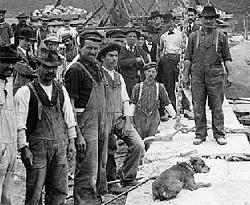
 |
|
| WACHUSETT DAM WORK CREW View Larger Image (84K) |
At this time, the following water sources were considered: the Nashua River, Lake Winnipesaukee, Sebago Lake, and the Merrimac River. Under the leadership of Frederic Stearns, Chief Engineer of the Metropolitan Water Board, it was decided that the new water source should be gravity-operated and not require filtration.
In 1897, the Nashua River above the town of Clinton was impounded by the Wachusett Dam. Six and 1/2 square miles were flooded in the towns of Boylston, West Boylston, Clinton and Sterling. and its water conveyed by the Wachusett/Weston Aqueduct to Weston Reservoir and then by pipeline to the Chestnut Hill and Spot Pond Reservoirs. Work was completed in 1905 and the reservoir first filled in May 1908.
The Wachusett system was built to service the 29 municipalities within the 10 mile radius of the State House. At the time, the Wachusett Reservoir was the largest public water supply reservoir in the world.
Water from the Wachusett Aqueduct could be released into the reservoirs of the Sudbury River system for transport to Boston via the Sudbury Aqueduct. Water from the Wachusett Reservoir could also flow through the new Sudbury Reservoir to the Weston Aqueduct.
During this period, Chestnut Hill Resrvoir was the hub of the system.
WACHUSETT SYSTEM SUMMARY
|
WACHUSETT SYSTEM SUMMARY FUTURE PLANS
With rehabilitation of the Low Service system, three Weston Aqueduct Supply Mains (WASM) will be cleaned and lined and their old reduced-size gate valves replaced with line-size butterfly valves. These three mains will have the capacity to deliver 125 mgd from the new Weston Covered Storage Facility to the combined Boston and Northern Low Service areas.
Go to Next
Back to Water System History